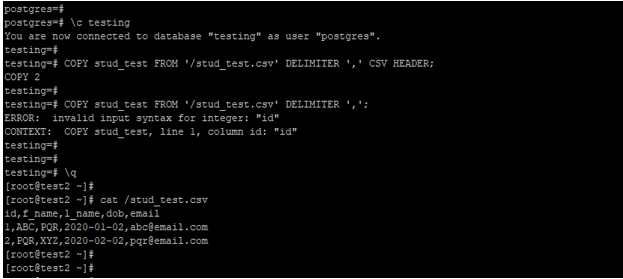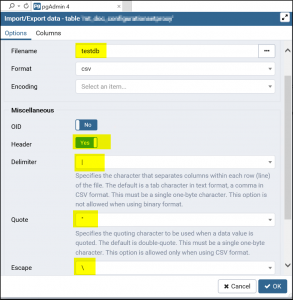


- UPLOAD CSV LOCALLY INTO AWS POSTGRESQL HOW TO
- UPLOAD CSV LOCALLY INTO AWS POSTGRESQL INSTALL
- UPLOAD CSV LOCALLY INTO AWS POSTGRESQL CODE
This folder contains loan_default and utils packages - the loan_default package contains the server-side python modules that support our three main APIs.
UPLOAD CSV LOCALLY INTO AWS POSTGRESQL CODE
The majority of the ML application code is in the app/ folder. The directory tree below outlines the codebase’s various scripts, assets, and configuration files. Inference - This endpoint receives a payload with raw data and returns the loan default classification of each sample.Model Training - This endpoint trains an XGBoost Classifier and converts it to an inference-optimized daal4py format.This codebase also handles the expansion of the dataset for benchmarking purposes. Data processing - This endpoint preprocess data and stores it in a data lake or another structured format.

We refactored the code from this reference solution to be more modular in support of our three main APIs: The application we will be deploying is based on the Loan Default Risk Prediction AI Reference Kit.
UPLOAD CSV LOCALLY INTO AWS POSTGRESQL INSTALL
curl -LO "$(curl -L -s )/bin/linux/amd64/kubectl" curl -LO "$(curl -L -s )/bin/linux/amd64/kubectl.sha256" echo "$(cat kubectl.sha256) kubectl" | sha256sum -check sudo install -o root -g root -m 0755 kubectl /usr/local/bin/kubectl Our Loan Default Prediction Application It allows users to deploy, inspect, and manage applications and services running on a Kubernetes cluster and perform various administrative tasks such as scaling, updating, and deleting resources. Install kubectl - Kubectl is a command-line tool for interacting with Kubernetes clusters. aws-iam-authenticator $HOME/bin/aws-iam-authenticator & export PATH=$PATH:$HOME/bin echo 'export PATH=$PATH:$HOME/bin' > ~/.bashrc aws-iam-authenticator help aws-iam-authenticator mkdir -p $HOME/bin & cp. Install aws-iam-configurator - AWS IAM Authenticator is a command-line tool that enables users to authenticate with their Kubernetes clusters on EKS using their AWS IAM credentials. curl -silent -location "$(uname -s)_" | tar xz -C /tmp sudo mv /tmp/eksctl /usr/local/bin eksctl version Install eksctl - eksctl is a command-line tool for creating, managing, and operating Kubernetes clusters on EKS. aws/installĬonfigure AWS Credentials using aws config - learn more about setting credentials with aws cli here. curl "" -o "awscliv2.zip" sudo apt install unzip unzip awscliv2.zip sudo. Install the AWS CLI - The AWS CLI (Command Line Interface) tool is a command-line tool for managing various Amazon Web Services (AWS) resources and services. You can find all of the source code for this tutorial in our public GitHub Repository.
UPLOAD CSV LOCALLY INTO AWS POSTGRESQL HOW TO
Additionally, they will have a practical example of how to leverage these technologies to accelerate the inference of a loan default prediction model. Image Sourceīy the end of this article, readers will have a basic understanding of how to build and deploy performant AI applications on the AWS cloud using Kubernetes, Docker, and the Intel AI Analytics Toolkit. Built to help provide an abstraction to Intel(R) oneAPI Data Analytics Library for either direct usage or integration into one’s framework. A simplified API to Intel(R) oneAPI Data Analytics Library that allows for fast usage of the framework suited for Data Scientists or Machine Learning users. We will also introduce the AWS services that we will use in the process, including Amazon Elastic Kubernetes Service (EKS), Amazon Elastic Container Registry (ECR), Amazon Elastic Compute Cloud (EC2), and Elastic Load Balancer (ELB).įigure 2. Specifically, we will focus on one of the first Intel Cloud Optimization Modules, which serves as a template with codified Intel accelerations covering various AI workloads. In this article, we will explore how to use Kubernetes, Docker, and the Intel AI Analytics Toolkit to build and deploy AI applications on the AWS cloud. Moreover, by using cloud services like Amazon Web Services (AWS), developers can further streamline the process and take advantage of the flexible and scalable infrastructure provided by the cloud. Fortunately, modern technologies such as Kubernetes, Docker, and the Intel AI Analytics Toolkit ( AI Kit) make it easier to develop and deploy AI applications optimized for performance and scalability. Building and deploying high-performance AI applications can be a challenging task that requires a significant amount of computing resources and expertise.


 0 kommentar(er)
0 kommentar(er)
